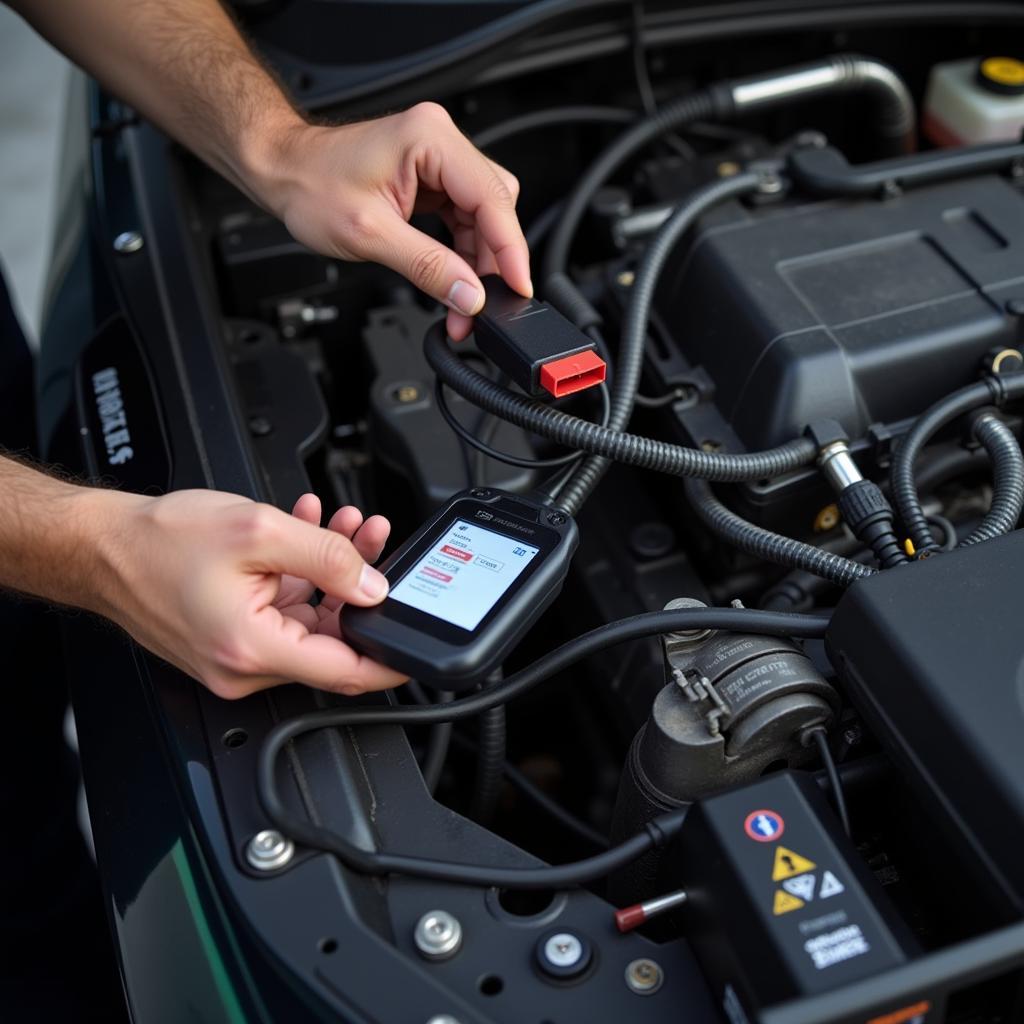The dreaded check engine light, a beacon of uncertainty for car owners everywhere. This small, often orange, light can illuminate for various reasons, leaving you wondering about the severity of the problem and the potential cost of repairs. Whether you’re a seasoned gearhead or a casual driver, understanding the Diagnostic Car Check Engine Light is crucial for responsible vehicle ownership.
What Triggers the Check Engine Light?
Your car’s engine control unit (ECU), essentially its brain, constantly monitors various sensors and systems. When the ECU detects an issue, it triggers the check engine light to alert you. The light itself doesn’t indicate a specific problem but serves as a general warning signal.
Here are some common culprits behind a glowing check engine light:
- Emissions System Problems: Issues with the oxygen sensor, catalytic converter, or evaporative emissions system can trigger the light.
- Loose Gas Cap: Believe it or not, a loose or missing gas cap can disrupt the evaporative emissions system and activate the check engine light.
- Faulty Spark Plugs or Ignition Coils: Worn spark plugs or ignition coils can lead to misfires, which the ECU will promptly flag.
- Sensor Malfunctions: A malfunctioning mass airflow sensor (MAF), throttle position sensor, or manifold absolute pressure sensor can disrupt the air-fuel mixture, impacting engine performance.
 Car Dashboard with Check Engine Light Illuminated
Car Dashboard with Check Engine Light Illuminated
Why You Shouldn’t Ignore the Check Engine Light
While a check engine light doesn’t always indicate a catastrophic problem, ignoring it can lead to more severe damage and costly repairs down the road. A minor issue left unattended can snowball into a major engine malfunction.
Here’s why promptly addressing the check engine light is crucial:
- Prevent Further Damage: Addressing the underlying issue early can prevent further damage to your engine and related components.
- Ensure Optimal Performance: A malfunctioning engine component can impact fuel efficiency, performance, and overall drivability.
- Avoid Safety Hazards: In some cases, ignoring the check engine light can lead to safety hazards, such as engine stalling or reduced braking ability.
- Pass Emissions Tests: Most states require vehicles to pass emissions tests, and a glowing check engine light will likely result in a failed test.
What to Do When the Check Engine Light Comes On
1. Don’t Panic: A check engine light doesn’t always mean an immediate breakdown. However, it’s best to err on the side of caution and have your vehicle inspected as soon as possible.
2. Check Your Gas Cap: Ensure your gas cap is securely tightened. A loose gas cap is a common and easily fixable trigger for the check engine light.
3. Note Any Performance Changes: Pay attention to any changes in your car’s performance, such as rough idling, decreased fuel efficiency, or unusual noises. This information can be helpful when diagnosing the problem.
4. Get a Diagnostic Scan: The most effective way to pinpoint the issue is to have your vehicle scanned with a diagnostic tool. This tool can read the error codes stored in your car’s ECU, providing valuable insights into the problem.
 Mechanic Performing a Diagnostic Scan on a Car
Mechanic Performing a Diagnostic Scan on a Car
You can take your car to a mechanic, or, for a more budget-friendly option, consider using a Nonda car diagnostic scanner, a handy and affordable tool for DIY car maintenance.
car diagnostic without check engine light can also be helpful in identifying potential issues before they trigger the check engine light, allowing for proactive maintenance.
Diagnosing and Resolving Check Engine Light Issues
Once you’ve identified the error codes using a diagnostic tool, you can begin troubleshooting the problem. While some repairs may be straightforward, others can be more complex and require the expertise of a qualified mechanic.
Here are some possible solutions based on common error codes:
- Oxygen Sensor Replacement: If the diagnostic scan reveals a faulty oxygen sensor, replacing it is usually a straightforward repair.
- Catalytic Converter Repair or Replacement: A malfunctioning catalytic converter can be costly to repair or replace, but it’s essential for reducing harmful emissions.
- Spark Plug or Ignition Coil Replacement: Worn spark plugs or ignition coils can be replaced to restore proper engine combustion.
- Mass Airflow Sensor Cleaning or Replacement: A dirty or faulty MAF sensor can often be cleaned, but replacement may be necessary in some cases.
Remember, while some repairs can be done at home with some mechanical know-how, it’s always advisable to consult with a qualified mechanic for complex issues or if you’re unsure about tackling the repair yourself.
Conclusion
The diagnostic car check engine light is your car’s way of communicating that something needs attention. Ignoring this warning can lead to more significant problems and costlier repairs in the long run. By understanding the common causes, taking prompt action, and utilizing diagnostic tools, you can keep your car running smoothly and avoid potential headaches down the road.
Don’t hesitate to seek free car diagnostic check engine light services available in many areas to get a head start on understanding and addressing any issues. Remember, a little preventative maintenance goes a long way in ensuring the longevity and reliability of your vehicle.

Leave a Reply